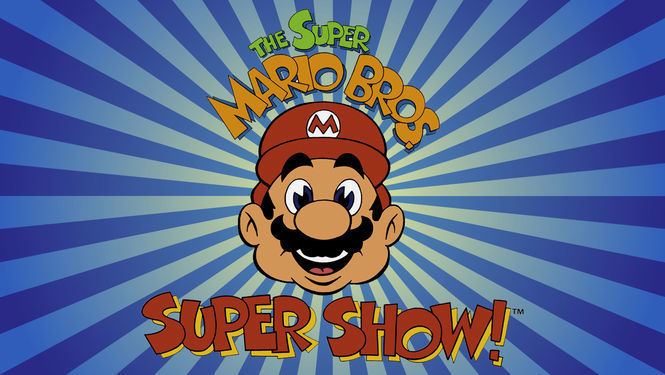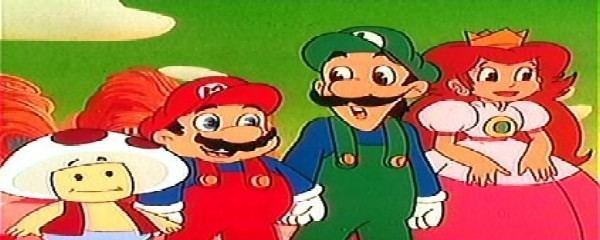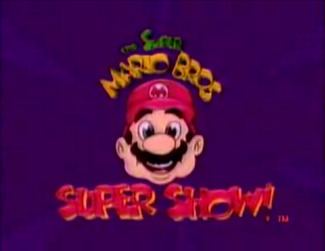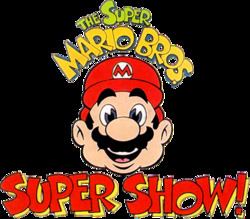7.2 /10 1 Votes
8.2/10 TV Final episode date 1 December 1989 | 6.3/10 IMDb Starring Lou AlbanoDanny Wells First episode date 4 September 1989 Network Pop | |||||||||||||||||||||||||||||||||
 | ||||||||||||||||||||||||||||||||||
Genre AdventureFantasyComedy Voices of Lou AlbanoDanny WellsJeannie EliasJohn StockerHarvey AtkinCyndy PrestonJonathan PottsLen CarlsonColin FoxAllen Stewart-CoatesElizabeth HannaPaulina Gillis Cast | ||||||||||||||||||||||||||||||||||
Super mario bros super show episode 1 the bird the bird
The Super Mario Bros. Super Show! is an American television series based upon Nintendo's Super Mario Bros. and Super Mario Bros. 2. It is the first of three TV shows based on the video game series, with the other being The Adventures of Super Mario Bros. 3 and Super Mario World. It was originally broadcast via first-run syndication from September 4, 1989 to December 1, 1989, with reruns continuing until September 6, 1991. The Family Channel picked up the series on September 23, 1991, and aired it until August 26, 1994. The show was produced by DiC Animation and was distributed by Viacom Enterprises in association with Nintendo of America, Inc., DHX Media, the successor company of Cookie Jar Entertainment and DiC, is the current distributor.
Contents
- Super mario bros super show episode 1 the bird the bird
- Mario Bros Plumbing
- Super Mario Bros
- The Legend of Zelda
- Club Mario
- Mario All Stars
- Theme songs
- Featured songs
- Super Mario Bros cast
- The Legend of Zelda cast
- Additional voices
- Club Mario cast
- Home video releases
- UK VHS history
- Reception
- References

Mario Bros. Plumbing

The first and last parts of each episode were live segments which showed Mario (professional wrestler and manager Captain Lou Albano) and Luigi (Danny Wells), two Italian-American plumbers living in Brooklyn, where they would often be visited by celebrity guest stars. It appears that the live segments take place before Mario and Luigi went to the Mushroom Kingdom.

Some of the celebrity guest stars were popular television stars, such as Nedra Volz, Norman Fell, Donna Douglas, Eve Plumb, Vanna White, Jim Lange, Danica McKellar, Nicole Eggert, Clare Carey and Brian Bonsall or professional athletes such as Lyle Alzado and Magic Johnson and WWE (then WWF) stars like Roddy Piper and Sgt. Slaughter. In one episode, Ernie Hudson appeared as a Slimebuster, a parody of his Ghostbusters persona Winston Zeddemore and on another occasion Mario and Luigi receive a visit from Inspector Gadget, performed live by Maurice LaMarche who voiced Chief Quimby in the second season of the show and later went on to voice Gadget himself in Inspector Gadget's Last Case and Gadget & the Gadgetinis. There was also another episode with Cassandra Peterson as Elvira, Mistress of the Dark, but the episode was not included in the DVDs. In an interview for the first DVD release of the show, Lou Albano talked about filming these live action skits, which mainly involved he and Wells getting a central plot and mostly improvising the dialogue as they went along.

In one episode, Lou Albano portrays himself, forcing his regular character to leave the scene in order for himself to appear. In the episode in question, pop star Cyndi Lauper states she's looking for Lou Albano because he's missing, due to the note she got from him (although there is an important part missing from the note). Mario exclaims how much he wants to meet Lou, and later Lou appears as himself supposedly while Mario's out shopping for pizza. As a result, Luigi gets to meet Lou, but Mario does not.
Lou Albano and Danny Wells also once played female versions of themselves, Marianne and Luigeena (their cousins), and also two hillbilly cousins, named Mario Joe and Luigi Bob.
Super Mario Bros.
Each Super Mario Bros. cartoon served as the second segment of every show, following the introduction and first few minutes of the episode's live-action segment. The cartoon featured characters and situations based upon the NES games Super Mario Bros. and Super Mario Bros. 2, as well as several sound effects and musical cues from the two games. Each episode featured Mario, Luigi, Toad and Princess Toadstool defending the Mushroom Kingdom from the reptilian villain King Koopa, often in a movie or pop-culture parody. Getting into the spirit of these parodies, Koopa often used alter egos fitting the current theme.
The theme song for the cartoon segments revealed that the Super Mario Brothers were accidentally warped into the Mushroom Kingdom while working on a bathtub drain in Brooklyn. After traveling via the warp drain, the Super Mario Brothers defeated King Koopa's Koopa Troopas, saved Princess Toadstool and halted Koopa's plan to conquer the Mushroom Kingdom. At the beginning of every cartoon segment, Mario recites an entry into his "Plumber's Log", a parody of the Captain's Log from Star Trek.
When Mario and Luigi are in danger, they often do their Patty-Cake routine: "Patty-cake, Patty-cake, Pasta-Man! Gimme Pasta power as fast as you can!" then everything becomes possible.
The Super Mario Bros. cartoons aired four days a week, from Monday through Thursday.
The Legend of Zelda
On every Friday episode of The Super Mario Bros. Super Show, a cartoon based on The Legend of Zelda video game series was featured instead of the Super Mario Bros. cartoons, in which the Hylian hero Link and Princess Zelda battled against the forces of the evil wizard Ganon. Scenes from each episode of the show were shown during the sitcom segments on the preceding Super Mario Bros. Super Show! episodes during the week, and then broadcast as sneak peeks. The Zelda cartoons consisted of thirteen episodes, which ended when the Super Mario Bros. Super Show! ended its initial broadcast run. The characters of Link, Zelda and Ganon, along with their respective voice actors (Jonathan Potts, Cynthia Preston and Len Carlson), were later featured in an episode of Captain N: The Game Master, based on the Zelda II: The Adventure of Link NES game, another animated series based on NES video games, and also produced by DiC Animation around the same period, airing on NBC as part of its Saturday morning cartoon schedule.
Club Mario
In the 1990–91 season after the original animated series had ended, the Albano/Wells live-action sequences were replaced on September 10, 1990 with new continuity under the title Club Mario. The Super Mario Bros. cartoons (as well as The Legend of Zelda on Fridays) remained intact but the live-action format now featured Mario-obsessed teenagers Tommy and Tammy Treehugger, along with Cool MC "commandeering" the "satellite signal" of the Super Show using a satellite dish atop their apartment building (despite the reality of the show going out on tapes to stations well in advance), goofing around, and in at least one episode, running around the studio and harassing DiC executive and executive producer Andy Heyward. Cool MC also had to deal with his evil twin Eric (played by the same actor), who attempted fruitlessly to take over the show. An additional added segment was a one-to-two-minute viewing of Space Scout Theater/Spaced Out Theater, hosted by Princess Centauri, a green alien woman, which was sourced and edited from the science fiction children television series, Photon. The segments had an unpopular reception and further distribution of the series after the 1990–91 season has featured only the original cut of the show with the Albano/Wells live-action sequences.
Mario All Stars
In 1993, The Family Channel aired the show in a package named Mario All Stars, consisting of time compressed versions of The Super Mario Bros. Super Show! cartoon segments and the Super Mario World cartoons. It ran for 39 episodes in double episode format, and was promoted as "the Super Mario Bros. in 40 brand new adventures". Although clips from the Super Mario Bros. 3 cartoons were used in promos for the show, none of the show's episodes were featured. All Stars was later seen on the USA Network from January 6 – June 6, 1997, when it was replaced by Sonic the Hedgehog reruns. Before being re-edited for All Stars in 1993, Family Channel played the episodes slower than their normal speed and included the live action segments. The package's title is most likely inspired by the title of the video game compilation Super Mario All-Stars that was released the previous year.
Theme songs
Featured songs
At some point in the cartoon segments, a song would be played to go along with the scene. These were usually notable singles from famous singers, songwriters, and musical artists of the era. When the program was re-released on DVD in North America, the songs were replaced by instrumentals of songs from The Adventures of Super Mario Bros. 3 and one song from Super Mario World. Episode/song combinations are shown on the list of Mario television episodes.
Super Mario Bros. cast
The Legend of Zelda cast
Additional voices
Club Mario cast
Home video releases
From 1989 to 1990, Kids Klassics released episodes of the series on VHS. Starting in 1991, Kids Klassics' parent company GoodTimes Entertainment continued releasing episodes on VHS up through 1993.
1989 Releases (Each volume begins and ends with a complete live-action segment, with the featured complete animated segment in the middle)
There were also 3 VHS tapes only available through a mail-in offer with Nestle Quik. They follow the same format as the volumes listed above.
1990 Releases (Each volume has 1 complete live action segment and 3 complete animated segments)
1991 Releases (The Kids Klassics logo is retained although these volumes were released by GoodTimes) (Each volume has 4 complete animated segments and no live-action segments)
1993 Release (Released in a clamshell packaging, contains 6 complete animated sgements and no live-action segments)
In 1996, the animated segment "Koopa Klaus" and the live-action segment "Santa Claus is Coming to Flatbush" were included on the VHS release Super Mario Bros. Super Christmas Adventures, alongside the Super Mario World episode "The Night Before Cave Christmas".
In 2006, Shout! Factory and Sony BMG Music Entertainment released the series on two 4-disc DVD sets.
These two sets were discontinued in 2012 after Shout!'s deal with Cookie Jar Entertainment expired.
Notably, a bare bones "Best of" DVD was released by DiC and Lions Gate Entertainment. In 2012 NCircle Entertainment released the complete series to DVD across two sets with the same extras as the Shout! Factory sets, but with the live-action segments omitted and "On Her Majesty's Sewer Service" excluded.
UK VHS history
Reception
The Super Mario Bros. Super Show! recived mixed to mostly positive and some mostly negative reviews, Common Sense Media rated the show 1 out of 5 stars, stating that the "frenetic '80s cult fave with stereotypes hasn't aged well."
